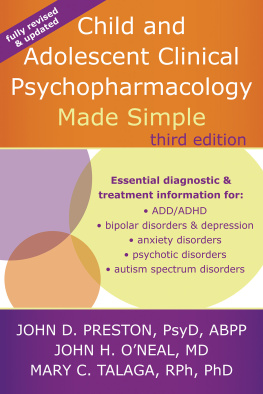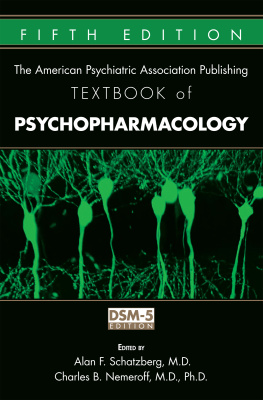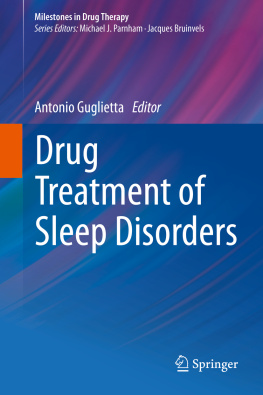
VST.Epub.contentReady(window, document); VST.cfiBase='/4';
p.i
Psychopharmacology
With increases in the prevalence of psychiatric and behavioral disorders and rapid advances in the development of new drug therapies, there is an increasing need to present the science behind these developments. Students and educators are often confronted with conflicting and exaggerated claims about the effectiveness of drugs. As recently as ten years ago, the mechanisms of action of many medications prescribed for common psychological disorders were not well understood, even by the scientists developing them. Now, drug treatment has advanced to a stage where drugs are designed for their effects on specific receptors, membrane proteins, or secondary messengers within particular cells in the brain. This text introduces a sufficient background in neuroanatomy and physiology so students can comprehend the necessary details of drug action.
Psychopharmacology, Second Edition, presents its subject matter in the context of the behavioral disorders they are designed to treat, rather than by traditional drug classifications. Students are often familiar with the major diagnostic categories, so presenting psychopharmacology as it pertains to these familiar disorders strengthens their understanding of the physiology and neurochemistry underlying them as well as the approaches to their treatment. Each disorder is discussed from a historical context along with diagnostic criteria and descriptions of typical cases. In addition, what we presently know about the underlying pathology of each disorder is carefully described. A critical examination of drug claims is missing from most psychopharmacology texts, but is offered here. Students will read about the most current research available from a critical perspective. When alternatives to traditional drug therapies are supported by research, these studies are presented as well. Throughout, this text discusses how drug effectiveness is measured in both human and animal studies.
Psychopharmacology has contributed significantly over the past 75 years to the treatment of severe psychological disorders as well as to our understanding of the brain and human behavior. This symbiotic relationship between psychopharmacology and the neural and behavioral sciences will continue long into the future. This fully updated second edition is ideal for undergraduate and pre-professional students, and includes a robust companion website.
R. H. Ettinger is P rofessor of Psychology at Eastern Oregon University. His research focuses on psychopharmacology, and includes investigations of the neural mechanisms underlying feeding and addiction. Notably, it has led to the development of an anti-cocaine antibody and an understanding of the role of Pavlovian conditioning in drug tolerance and addiction.
VST.Epub.contentReady(window, document); VST.cfiBase='/4';
p.iii
Psychopharmacology
Second Edition
R. H. Ettinger

VST.Epub.contentReady(window, document); VST.cfiBase='/4';
p.iv
Second edition published 2017
by Routledge
711 Third Avenue, New York, NY 10017
and by Routledge
2 Park Square, Milton Park, Abingdon, Oxon, OX14 4RN
Routledge is an imprint of the Taylor & Francis Group, an informa business
2017 Taylor & Francis
The right of R. H. Ettinger to be identified as author of this work has been asserted by him in accordance with sections 77 and 78 of the Copyright, Designs and Patents Act 1988.
All rights reserved. No part of this book may be reprinted or reproduced or utilised in any form or by any electronic, mechanical, or other means, now known or hereafter invented, including photocopying and recording, or in any information storage or retrieval system, without permission in writing from the publishers.
Trademark notice: Product or corporate names may be trademarks or registered trademarks, and are used only for identification and explanation without intent to infringe.
First edition published by Pearson 2011
Library of Congress Cataloging in Publication Data
Ettinger, R. H., author.
Psychopharmacology / R.H. Ettinger.Second edition.
p. ; cm.
Includes bibliographical references and index.
ISBN 978-1-138-83307-4 (hbk : alk. paper)ISBN 978-1-138-83308-1 (pbk : alk. paper)ISBN 978-1-315-26932-0 (ebk)
I. Title.
[DNLM: 1. Psychotropic Drugspharmacology. 2. Psychotropic Drugstherapeutic use. 3. Central Nervous Systemdrug effects. 4. Mental Disordersdrug therapy. 5. Mental Disordersphysiopathology. QV 77.2]
RM315
615.78dc23
2015009214
ISBN: 978-1-138-83307-4 (hbk)
ISBN: 978-1-138-83308-1 (pbk)
ISBN: 978-1-315-26932-0 (ebk)
Typeset in Times New Roman
by Swales & Willis, Ltd, Exeter, Devon, UK
Visit the companion website: www.routledge.com/cw/ettinger
VST.Epub.contentReady(window, document); VST.cfiBase='/4';
p.1
Our behaviors, including our thoughts, sensations, emotions, memories, and even our states of consciousness, are all a result of complex interactions between neurons distributed throughout our brains. These neurons form elaborate systems that communicate their activity by releasing small amounts of transmitter substances which act both on receiving neurons as well as on the neuron sending the message. In order for us to understand just how drugs act to treat certain psychological conditions, we must first understand the intricate and sometimes subtle ways in which neurons function to regulate our behaviors. We must also appreciate the complex systems of neurons within the brain that specialize in different functions including movement, emotions, learning and memory, and our motivational states.
The average human brain weighs approximately 1,400 grams (or roughly three pounds) and contains nearly 200 billion neurons. Each of these neurons may in turn communicate with just a few or as many as tens of thousands of other neurons. How the structure and organization of neurons and their surrounding environment allows for such communication will be the topic of the first part of this chapter. We will then describe the structures and functions of systems within the brain that allow humans and other organisms to function in, and adapt to, their continuously changing environments. This background will be necessary for us to understand how psychological disorders may arise and just how drugs might help to alleviate them.
The Structure and Function of Neurons
As mentioned above, the brain contains approximately 200 billion individual nerve cells or neurons. These neurons are the basic units of the brain as well as the rest of the nervous system. Neurons vary in shape, size, and other characteristics according to their location and their specific function.
There are three major classes of neurons: sensory neurons, motor neurons, and interneurons. Sensory or afferent neurons carry ascending messages to the central nervous system (CNS) from receptors in the skin, ears, nose, eyes, as well as some organs, muscles, and joints. The brain and sometimes the spinal cord interpret these messages and send appropriate responses through descending motor or efferent neurons, which lead to sensory organs, muscles, glands, and other peripheral tissues to control movement and the functioning of glands, sensory organs, and other tissues. Interneurons reside only within the CNS and function to bridge communication between sensory and motor neurons. Without these connecting neurons, sensory messages would never result in the appropriate bodily response. Interneurons also communicate with each other throughout the nervous system. Although neurons vary in size, shape, and function, they share four common structures: the cell body, the dendrites, the axon, and the terminal buttons (see ).
Next page













